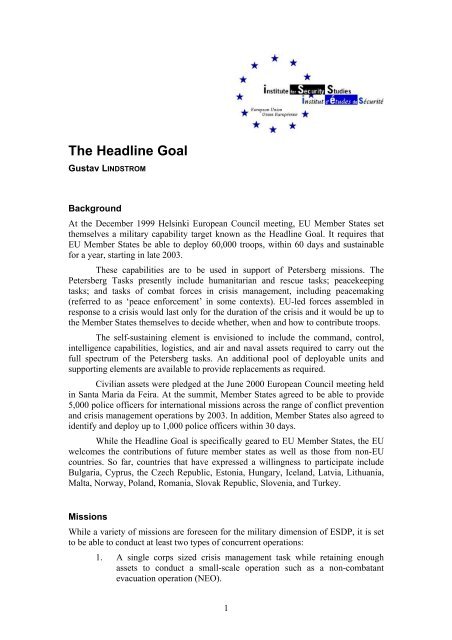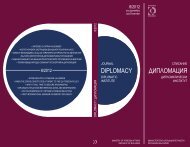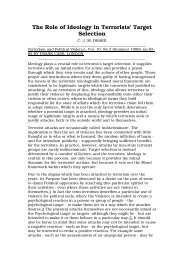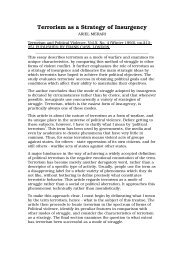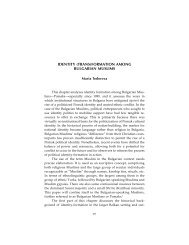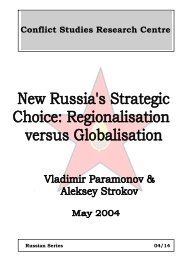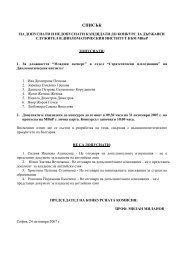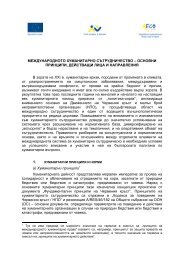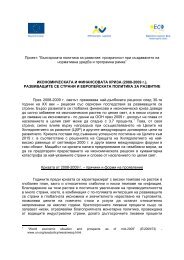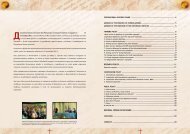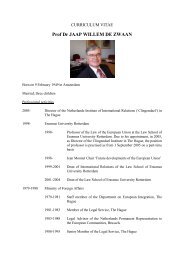Helsinki Headline Goal
Helsinki Headline Goal
Helsinki Headline Goal
You also want an ePaper? Increase the reach of your titles
YUMPU automatically turns print PDFs into web optimized ePapers that Google loves.
The <strong>Headline</strong> <strong>Goal</strong><br />
Gustav LINDSTROM<br />
Background<br />
At the December 1999 <strong>Helsinki</strong> European Council meeting, EU Member States set<br />
themselves a military capability target known as the <strong>Headline</strong> <strong>Goal</strong>. It requires that<br />
EU Member States be able to deploy 60,000 troops, within 60 days and sustainable<br />
for a year, starting in late 2003.<br />
These capabilities are to be used in support of Petersberg missions. The<br />
Petersberg Tasks presently include humanitarian and rescue tasks; peacekeeping<br />
tasks; and tasks of combat forces in crisis management, including peacemaking<br />
(referred to as ‘peace enforcement’ in some contexts). EU-led forces assembled in<br />
response to a crisis would last only for the duration of the crisis and it would be up to<br />
the Member States themselves to decide whether, when and how to contribute troops.<br />
The self-sustaining element is envisioned to include the command, control,<br />
intelligence capabilities, logistics, and air and naval assets required to carry out the<br />
full spectrum of the Petersberg tasks. An additional pool of deployable units and<br />
supporting elements are available to provide replacements as required.<br />
Civilian assets were pledged at the June 2000 European Council meeting held<br />
in Santa Maria da Feira. At the summit, Member States agreed to be able to provide<br />
5,000 police officers for international missions across the range of conflict prevention<br />
and crisis management operations by 2003. In addition, Member States also agreed to<br />
identify and deploy up to 1,000 police officers within 30 days.<br />
While the <strong>Headline</strong> <strong>Goal</strong> is specifically geared to EU Member States, the EU<br />
welcomes the contributions of future member states as well as those from non-EU<br />
countries. So far, countries that have expressed a willingness to participate include<br />
Bulgaria, Cyprus, the Czech Republic, Estonia, Hungary, Iceland, Latvia, Lithuania,<br />
Malta, Norway, Poland, Romania, Slovak Republic, Slovenia, and Turkey.<br />
Missions<br />
While a variety of missions are foreseen for the military dimension of ESDP, it is set<br />
to be able to conduct at least two types of concurrent operations:<br />
1. A single corps sized crisis management task while retaining enough<br />
assets to conduct a small-scale operation such as a non-combatant<br />
evacuation operation (NEO).<br />
1
2. A long-term operation at less than maximum level of effort while<br />
conducting another operation of a limited duration.<br />
On 1 January 2003, the EU launched its first civilian crisis management<br />
operation. The European Union Police Mission (EUPM) in Sarajevo is a follow-on<br />
operation to the United Nation’s International Police Task Force. Consisting of<br />
approximately 500 police officers representing over 30 countries, the objective is to<br />
establish sustainable policing arrangements under BiH ownership.<br />
On 31 March 2003, the EU launched its first military peacekeeping mission.<br />
Known as Operation Concordia, it succeeded NATO’s Allied Harmony operation in<br />
Macedonia. It consisted of roughly 350 personnel representing 27 different nations<br />
with access to NATO capabilities and assets. The mission’s objective was to<br />
guarantee a secure environment to facilitate FYROM government’s implementation<br />
of the August 2001 Ohrid Framework Agreement. The operation was finalised on<br />
December 15, 2003, giving way to the follow-on operation EUPOL Proxima. As the<br />
EU’s second police mission, Proxima aims to monitor, mentor and advise the<br />
Macedonian police force. The yearlong mission is made up some 200 police officers<br />
and has its headquarters in Skopje.<br />
On 5 June 2003, the EU Council formally gave the go-ahead to a second<br />
military peacekeeping mission. Operation Artemis was set-up to secure the town of<br />
Bunia in the Congolese province of Ituri. With France as the Framework nation, a<br />
total force of 1,500 personnel participated in the time-limited operation that concluded<br />
on September 1 st , 2003. Additional details on these missions are available on the<br />
operations page.<br />
Developments Post-<strong>Helsinki</strong><br />
The 20-21 November 2000 Capabilities Commitments Conference: Reinforcing<br />
Military Capabilities and Identifying Shortcomings<br />
To operationally meet the requirements established by the <strong>Headline</strong> <strong>Goal</strong>, a<br />
Capabilities Commitments Conference (CCC) was organized in late 2000. The<br />
preparatory work was carried out by a ‘<strong>Headline</strong> <strong>Goal</strong> Task Force (HTF) created at<br />
Feira. When EU-NATO relations were addressed, the HTF was reinforced by the<br />
participation of NATO experts under the ‘HTF-plus’ arrangement. Building on the<br />
initial reviews of available, expected, and required forces and assets discussed in July<br />
2000 by means of a confidential <strong>Helsinki</strong> <strong>Headline</strong> Catalogue, the CCC specified the<br />
following assets in support of the <strong>Headline</strong> <strong>Goal</strong> (the Catalogue was updated prior to<br />
the CCC in mid-September 2000):<br />
• 100,000 personnel;<br />
• 400 combat aircraft; and,<br />
• 100 naval vessels<br />
2
The Conference also made it possible to identify a number of areas in which<br />
efforts are needed to upgrade existing assets, investment, development, and<br />
coordination to enhance the capabilities required for autonomous EU action.<br />
The 19 November 2001 Capability Improvement Conference: Addressing the<br />
Capability Gaps<br />
At the Capability Improvement Conference (CIC), Member States identified<br />
additional shortcomings and agreed on a plan of action to remedy them. Identified<br />
challenge areas include force protection, logistics, and operational mobility.<br />
Improvements were similarly suggested for specific mission requirements, including<br />
the acquisition of related technologies.<br />
By the end of 2001, five of the 55 major shortfalls identified by the CIC had<br />
been resolved (Military Balance 2002·2003). To remedy these gaps, a European<br />
Capability Action Plan (ECAP) was agreed upon by member states (see section on<br />
ECAP for details).<br />
Current operational status<br />
According to the 28 February 2000 “Food for Thought” Paper, the <strong>Headline</strong><br />
<strong>Goal</strong> is to be met by June 2003 if possible and by December 2003 at the latest.<br />
However, according to the December 2001 Laeken Presidency Conclusions, the<br />
“Union is now capable of conducting some crisis-management operations.” This<br />
position was confirmed at the May 2003 General Affairs and External Relations<br />
Council which states that “the EU now has operational capability across the full range<br />
of Petersberg tasks, limited and constrained [only] by recognised shortfalls.”<br />
3
Table X: Likely EU Force Components Available for Crisis Management Operations<br />
(Selected EU nations)<br />
Country Maritime Ground<br />
(No. of personnel)<br />
Air<br />
Austria 1 mech inf battalion (PKO)<br />
1 light inf battalion<br />
1 NBC unit (2,000)<br />
1 transport helo squadron<br />
Belgium 2 frigates<br />
1 mech inf brigade 1 squadron F-16 (24)<br />
6 MCMV<br />
1 command ship<br />
8 C-1302 Airbus<br />
Finland 1 mech inf battalion<br />
1 transport company<br />
1 CIMIC company (2,000)<br />
France 1 SSN<br />
HQs and C4ISR<br />
1 air-naval group<br />
2 aircraft carriers (22 combat a/c 1 light inf brigade<br />
75 combat a/c<br />
each)<br />
1 armoured division<br />
1 AWACS<br />
2 amphibious ships<br />
1 airborne division<br />
8 tanker a/c<br />
4 frigates<br />
1 amphibious division<br />
3 transport a/c (LR)<br />
3 spt ships<br />
Special forces (12,000) 24 transport a/c (MR)<br />
Germany 13 ships<br />
HQ GE/NE Corps<br />
6 squadrons combat a/c<br />
1 amphibious transport ship 18,000 (all elements) incl. 7<br />
combat battalions<br />
8 air defence squadrons<br />
Greece 8 ships 1 operational HQ<br />
1 combat helo unit<br />
1 mech inf brigade<br />
1 transport helo unit<br />
1 light inf battalion<br />
42 combat a/c<br />
4 transport a/c<br />
1 Patriot air defence battalion<br />
1 SHORAD squadron<br />
Ireland 1 light inf battalion<br />
Special forces group (850)<br />
Italy 1 maritime HQ<br />
Operational level HQ C3I 26 Tornado and AMX combat<br />
1 aircraft carrier (6 combat a/c, Corps level HQ<br />
a/c<br />
8 helo)<br />
1 CIMIC group<br />
6 CSAR helos<br />
1 destroyer<br />
Special forces (12,500- 4 C-130J a/c<br />
3 frigates<br />
14,500)<br />
2 tanker a/c<br />
4 ptl ships<br />
3 MPA<br />
1 submarine<br />
4 MCMV<br />
2 amphibious ships<br />
2 SHORAD units<br />
Luxembourg 1 light recce unit 1 A-400M (future)<br />
Netherlands 1 LPD<br />
HQ of 1 GE/NE Corps<br />
1 air brigade<br />
Air defence and command 1 mech inf brigade<br />
F-16 a/c<br />
frigates<br />
1 airmobile brigade<br />
1 amphibious battalion<br />
Portugal 1 frigate<br />
1 infantry brigade (4,000) 12 F-16<br />
1 submarine<br />
4 C-130 Hercules<br />
1 patrol boat<br />
12 C-212 tactical transport a/c<br />
1 sp ship<br />
3 MPA<br />
1 svy ship<br />
4 Puma helos<br />
Spain 1 division, 1 brigade HQs Air-navy unit<br />
1 mech brigade<br />
2 squadrons F-1/F-18 combat<br />
Mountain units<br />
a/c (24 total)<br />
1 light inf group<br />
Special forces<br />
1 transport squadron<br />
Sweden 2 corvettes<br />
1 mech inf battalion (900) 4 AJS 37 a/c (to be 8 JAS 30<br />
1 spt ship<br />
1 engineering unit (175) in 2004)<br />
1 MP unit (160)<br />
1 marine unit (206)<br />
4 C-130<br />
UK 1 aircraft carrier<br />
1 mobile joint HQ<br />
72 combat a/c<br />
2 SSN<br />
1 armed mech brigade 58 strategic transport a/c and<br />
4 destroyer/frigate<br />
1 amphibious brigade<br />
Chinook/Merlin helos<br />
1 helo carrier<br />
(12,500)<br />
Note: SSN= nuclear-fuelled submarine; HQ= headquarters; C4ISR= command, control, communication, computers, intelligence,<br />
surveillance and reconnaissance; LPD= landing platform, dock; Recce= reconnaissance; a/c= aircraft; spt= support; inf=<br />
infantry; mech= mechanised; helo= helicopter; ptl= patrol; CIMIC= Civil-Military Cooperation; svy= survey; SHORAD= Short<br />
Range Air Defence. Denmark did not take part in the Force Catalogue.<br />
Source: The Military Balance 2002·2003, The International Institute for Strategic Studies, London.<br />
4


